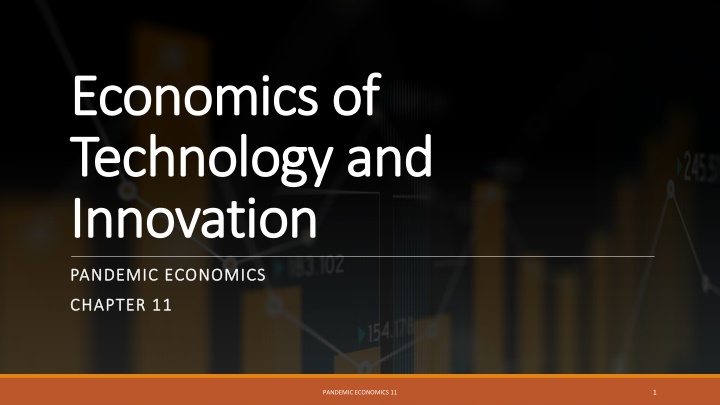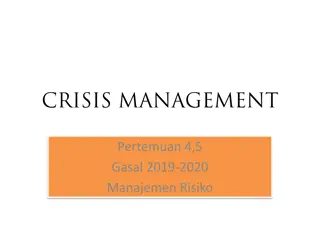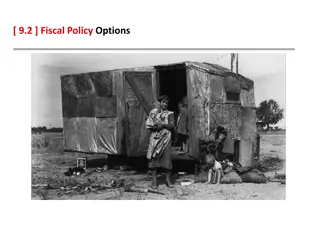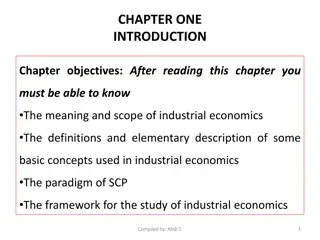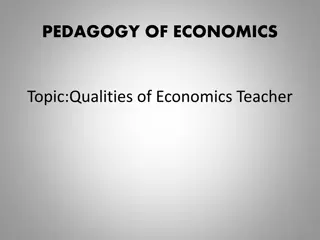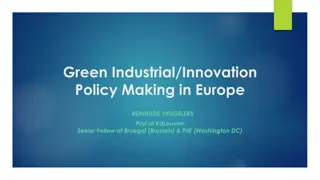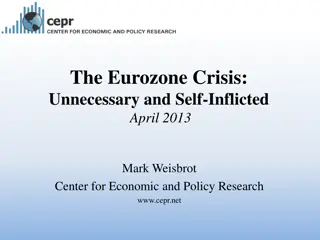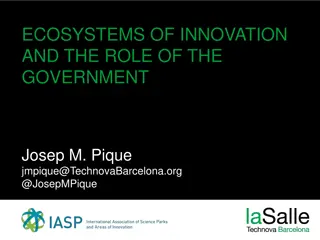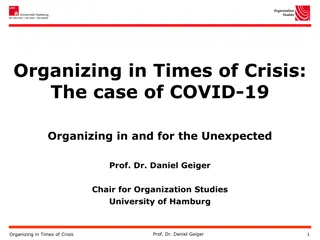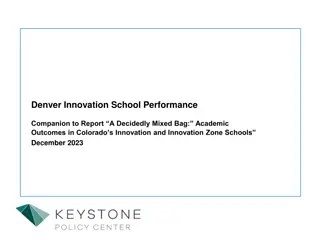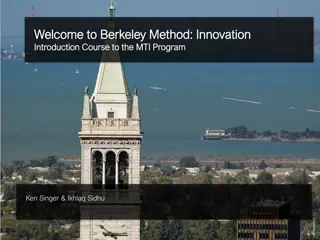Economics of Technology and Innovation in Times of Crisis
Innovation plays a crucial role during times of crisis such as a pandemic, driving advancements in technology, economic growth, and transformative change. This chapter explores the motivation for innovation, the process of technological advance, theories of economic growth, networks of innovation, and the lasting effects a pandemic can have on innovation.
Download Presentation

Please find below an Image/Link to download the presentation.
The content on the website is provided AS IS for your information and personal use only. It may not be sold, licensed, or shared on other websites without obtaining consent from the author.If you encounter any issues during the download, it is possible that the publisher has removed the file from their server.
You are allowed to download the files provided on this website for personal or commercial use, subject to the condition that they are used lawfully. All files are the property of their respective owners.
The content on the website is provided AS IS for your information and personal use only. It may not be sold, licensed, or shared on other websites without obtaining consent from the author.
E N D
Presentation Transcript
Economics of Economics of Technology and Technology and Innovation Innovation PANDEMIC ECONOMICS PANDEMIC ECONOMICS CHAPTER 11 CHAPTER 11 1 PANDEMIC ECONOMICS 11
Topics Topics 1. Innovation in a Time of Crisis 2. The Process of Technological Advance 3. Theories of Economic Growth 4. Networks of Innovation 5. Pandemics, Innovation, and Transformative Change 6. Lasting Effects 2 PANDEMIC ECONOMICS 11
Learning Objectives Learning Objectives After reading this chapter, you will be able to: After reading this chapter, you will be able to: LO1 Explain the motivation for innovation during a time of crisis. LO2 Discuss the process of technological advance, including the stages of invention, innovation, diffusion, and adoption/rejection. LO3 Contrast theories of economic growth that model technological advance as an exogenous variable and technological advance as an endogenous variable. LO4 Explain why networks enhance the process of innovation. LO5 Discuss innovation in a period of transformative change, including technological advances for vaccines and medical care. LO6 Address why a pandemic may lead to lasting effects with respect to innovation. 3 PANDEMIC ECONOMICS 10
A pandemic ravages public health and the economy, impacting industries, businesses, and households. But if history repeats itself, innovation emerges from crisis, when necessity fosters creation. 1. Innovation 1. Innovation in a Time of in a Time of Crisis Crisis 4 PANDEMIC ECONOMICS 11
Process of Innovation Process of Innovation The process of innovation the application of a new idea or new application of an existing idea stems from the desire to create new methods, markets, and products. When an exogenous shock strikes, such as a pandemic, the demand for new methods, markets, and products determines the quantity of investment. With the coronavirus pandemic, innovations occurred in both the development of a vaccine and clinical practices in medical care, including advances in diagnoses and telemedicine. Innovations also occurred in the marketplace. 5 PANDEMIC ECONOMICS 11
Innovation During a Pandemic Innovation During a Pandemic Most innovation occurs in labs, plants, and firms. The firms pay the bills and researchers are compensated with salaries. In modern economies, most innovation occurs in the private sector, but during a pandemic innovation also comes from universities and government labs. 6 PANDEMIC ECONOMICS 11
Joseph Schumpeter (1934), the prominent Austrian economist, describes economic development as a historical process of structural change. In Schumpeter s framework, structural change includes three stages: Invention Innovation Diffusion 2. The Process 2. The Process of of Technological Technological Advance Advance According to Schumpeter (1942), innovation causes periods of creative destruction: A process of industrial mutation incessantly revolutionizes the economic structure from within, incessantly destroying the old one, incessantly creating a new one. 7 PANDEMIC ECONOMICS 11
8 PANDEMIC ECONOMICS 11
Each Stage Has a Specific Purpose Each Stage Has a Specific Purpose Invention: the first occurrence of an idea for a new product or process. Innovation: the first attempt to carry it out into practice. Diffusion: the process in which an innovation is (spread) through certain channels over time among the members of a social system. After diffusion, a new product or method may be adopted or rejected, depending on market outcomes, network effects, and best practices. 9 PANDEMIC ECONOMICS 11
Attributes of Innovation Attributes of Innovation COMPATIBILITY COMPLEXITY The degree to which an innovation is consistent with the needs of potential adopters How difficult a product or method is to use 10 PANDEMIC ECONOMICS 11
OBSERVABILITY RELATIVE ADVANTAGE The extent to which potential adopters observe the benefits of the new method or product The degree to which it is perceived as better than the alternative 11 PANDEMIC ECONOMICS 11
TRIALABILITY The degree to which potential adopters may experiment with it 12 PANDEMIC ECONOMICS 11
Frames of Analysis for Technological Advance Frames of Analysis for Technological Advance Framings: interpretations of experience orderings of present circumstance imaginations of future potentialities that create the foundations for policy analysis and action shape expectations concerning potentials and opportunities 13 PANDEMIC ECONOMICS 11
Practitioners of New Ideas Practitioners of New Ideas Practitioners of new ideas connect time periods in the past, present, and future. The framings that result from these connections evolve over time, changing when they cannot adequately interpret existing circumstances. 14 PANDEMIC ECONOMICS 11
Framings Framings FIRST FRAMING: INNOVATION FOR GROWTH Addresses the impact of science and technological advance on economic prosperity SECOND FRAMING: SYSTEMS OF INNOVATION Grew in response to a level of incompleteness of the first framing, which was subsequently updated to reflect the growing realization of the impact of science on industry 15 PANDEMIC ECONOMICS 11
THIRD FRAMING: TRANSFORMATIVE CHANGE Considers how to use scientific knowledge and technological advance to meet contemporary challenges 16 PANDEMIC ECONOMICS 11
The Framing Perspective The Framing Perspective The framing perspective implies that technological advance leads to a certain directionality toward a positive outcome. But rejection remains a possibility, especially with the development of a vaccine. In addition, the innovations that emerge during a pandemic, such as remote work and online education, lead to the creative destruction or dismantling of previous practices, using Schumpeter s (1942) term. 17 PANDEMIC ECONOMICS 11
The process of innovation is not a new phenomenon. Inherent to human development, innovation characterizes economic activity, labor methods, and technological advance. 3. Theories of 3. Theories of Economic Economic Growth Growth 18 PANDEMIC ECONOMICS 11
Technology as an Exogenous Factor Technology as an Exogenous Factor The neoclassical growth model originates in the work of Robert Solow (1956), who posits a long-term relationship between economic growth and capital formation. Technology serves an explanatory variable that leads to the aspect of economic growth not explained by capital and labor. 19 PANDEMIC ECONOMICS 11
Technology as an Endogenous Factor Technology as an Endogenous Factor The idea of technology serving as an endogenous factor stems from Schumpeter (1947), who stresses the important roles of innovation and entrepreneurship in the process of economic growth. In this view, improvements in technology serve as the driving force behind rising living standards. 20 PANDEMIC ECONOMICS 11
A network is a system of interconnected elements, including nodes or agents and the connections between them. Innovation networksexist when collaborative efforts between agents contribute toward the development and creation of new markets, methods, and products. 4. Networks 4. Networks of Innovation of Innovation 21 PANDEMIC ECONOMICS 11
Model of Innovation Networks Model of Innovation Networks Innovation networks may exhibit high power-law functions, especially in the case of the development of a vaccine: A small number of agents have many connections and direct a large percentage of the flow of knowledge Hub firms, O = {o1, o2, , on}: Orchestrate the process of innovation and initiate the creation of value Network members, N = {n1, n2, , nn}: Adopt the methods and products established by the orchestrators 22 PANDEMIC ECONOMICS 11
23 PANDEMIC ECONOMICS 11
Orchestrators Orchestrators Through market share and previous success, orchestrators gain their position, in which they use to gather resources and capabilities. They create value by expanding the size of the market and extract value by increasing their degree of prominence in the network. From the perspective of hub firms, several intentional actions characterize the creation of value, including knowledge mobility, innovation appropriability, and network stability. 24 PANDEMIC ECONOMICS 11
KNOWLEDGE MOBILITY INNOVATION APPROPRIABILITY The first task for orchestrators in the creation of value is knowledge mobility: The second task for orchestrators in the creation of value is innovation appropriability: The ease with which knowledge is shared, acquired, and deployed within the network The ability of an innovator to capture the profits from an innovation 25 PANDEMIC ECONOMICS 11
NETWORK STABILITY The third task for orchestrators in the creation of value, network stability, means: Fostering stable links among network members. 26 PANDEMIC ECONOMICS 11
During a period of transformative change, both strategic and serendipitous alterations to society s methods of operation produce new interactions and outcomes. This transition leads to new ways to supply output. 5. Pandemics, 5. Pandemics, Innovation, Innovation, and and Transformative Transformative Change Change 27 PANDEMIC ECONOMICS 11
Examples Examples New interactions and outcomes create changes in how consumers purchase goods and services. For an economy, it leads to different degrees of product availability, affordability, quality, and reliability. Evolving attitudes toward the marketplace create new methods of organizational structure: Working from home using telecommunications technology New preferences for consumption, such as delivery on demand 28 PANDEMIC ECONOMICS 11
Innovation During a Crisis Innovation During a Crisis During a crisis, different firms innovate. One category, competitive firms that exhibit the characteristics of dynamic agents, cannot maintain market share without innovation. They participate in the process of creative accumulationand innovate as matter of routine. Another category, firms that serve as new innovators, are not members of the industry before the crisis. They take advantage of their opportunity to increase market share, launch new products, and participate in the process of creative destruction. 29 PANDEMIC ECONOMICS 11
Technological Advances During the Technological Advances During the Coronavirus Pandemic Coronavirus Pandemic VACCINATION ADVANCES IN MEDICAL CARE Vaccines have the potential to both stop the spread of an infectious disease and eradicate it. The coronavirus pandemic disrupted systems of clinical care, leading to innovations in virtual care, diagnosis, and therapy. 30 PANDEMIC ECONOMICS 11
Stages of Development of a Vaccine Stages of Development of a Vaccine Pre-clinical trials Building factories Research Clinical trials Distribution Approval Manufacturing 31 PANDEMIC ECONOMICS 11
Large-scale crises such as pandemics prompt acts of innovation. The medical system innovates new ways to provide care. Companies adapt to changing market circumstances through the process of technological advance, an example consisting of virtual work models. 6. Lasting 6. Lasting Effects Effects Households learn to use new methods of communication, consumption, and delivery. School systems learn to educate students through distance learning. 32 PANDEMIC ECONOMICS 11
Moving Forward Moving Forward Moving forward, the issue becomes the extent to which the process of technological advance that occurs during a crisis leads to lasting effects. Individuals, companies, and systems of organization could analyze the lessons of technological advance and apply them to periods of relative calm. But not all examples of technological advance that occur during crises offer a blueprint for sustainable methods of innovation. 33 PANDEMIC ECONOMICS 11
Tools for the Innovative Process Tools for the Innovative Process Lindsey Lyman (2020), a clinical professor of entrepreneurship at the Chicago Booth School of Business, argues that four tools used to assess economic conditions during a pandemic should become a part of the innovative process. Taken together, the tools provide a framework for creating solutions for upcoming problems: First, firms should challenge orthodoxies or pre-existing assumptions Second, constraints on methods, capacity, or delivery may accelerate and not inhibit the process of innovation Third, collaboration leads to competitive advantage Fourth, the process of technological advance often moves at a methodical pace 34 PANDEMIC ECONOMICS 11
